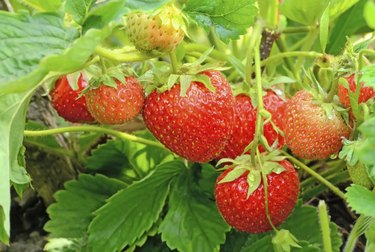
The cultivated strawberry plant (Fragaria x ananassa) is a low-grower that is perennial in U.S. Department of Agriculture plant hardiness zones 3 through 10, depending on its variety. Often, though, it is grown as an annual to maintain fruit yields. The characteristics of a strawberry plant depend on whether it is a June-bearing, everbearing or day-neutral cultivar. Plant nurseries often sell both everbearing and day-neutral cultivars as "ever-bearing" strawberries, though they are not the same.
June-Bearing Strawberries
Video of the Day
Classic strawberry cultivars bear a single, large crop of fruits in early summer, typically from late June to early July. Hence, they are commonly called June-bearers and June-bearing strawberries.
Video of the Day
Increasingly longer nights and shorter days from late September through early November trigger plant hormones that spur June-bearers to grow buds. The buds stay dormant during winter and grow flowers when the weather warms in spring. The flowers yield berries.
If you pick the June-bearers' buds in the first autumn, the plants will yield a far larger crop the second season. The plants should be replaced after the third year for maximum yields.
June-bearing strawberries grow runners, which are stems that extend along the ground and produce roots. With their runners, the plants form 24-inch-wide matted rows. Typically, the plants are spaced 18 to 24 inches apart with 4 feet between rows.
An example of a June-bearer is the cultivar "All Star" (Fragaria x ananassa "All Star," USDA zones 4 through 10), which grows 12 to 18 inches high and 12 to 15 inches wide.
Everbearing Strawberries
Gardeners remove runners from both everbearing and day-neutral strawberries, growing them as large, single plants spaced 1 foot apart with 1 foot between rows and a 2-foot-wide path between beds of three rows.
Everbearing strawberry cultivars produce two crops, a small one in spring and a larger one in early autumn. Between those crops, they either yield fruits periodically or none at all.
Replace everbearing plantings every other year.
"Ogallala" (Fragaria x ananassa "Ogallala," USDA zones 3 through 9) is an everbearing cultivar that produces flavorful, bright-red berries.
Day-Neutral Strawberries
Day-neutral strawberries grow flower buds regardless of the length of day, hence their name. When temperatures remain below 90 degrees Fahrenheit, day-neutral strawberries will yield berries continuously from early summer to autumn with three periods of peak yield.
Day-neutral strawberries are grown as annuals, planted anew each spring.
The day-neural "Seascape" (Fragaria ananassa "Seascape," USDA zones 4 through 9) yields large, flavorful berries during a long growing season.
Leaf Description
Medium- to dark-green hair petioles or stems that measure about 1 2/3 to 3 1/6 inches long hold up the evergreen to semi-evergreen leaves of strawberry plants.
The leaves grow at the end of the above-ground runners or in tightly compressed rosettes. Oval, the leaves are divided into three parts and are roughly 1 2/3 to 2 1/3 inches wide and 3/4 to 1 1/2 inches long. The leaf edges have coarse teeth.
The tops of the leaves of most cultivars are glossy, smooth and dark green. The bottoms are light green with whitish hairs.
- University of Kentucky Cooperative Extension Service: Strawberries
- Texas A&M University, Michael A. Arnold, Ph.D.: Fragaria x Ananassa, Strawberry
- National Gardening Association: Shedding Light on Day-Neutral Strawberries
- Oregon State University Extension Service: Strawberry Cultivars for Western Oregon and Washington
- Iowa State University Extension and Outreach: Yard and Garden -- Planting Strawberries
- University of Wisconsin Extension: Growing Strawberries in Wisconsin
- Old Farmer's Almanac: Strawberries